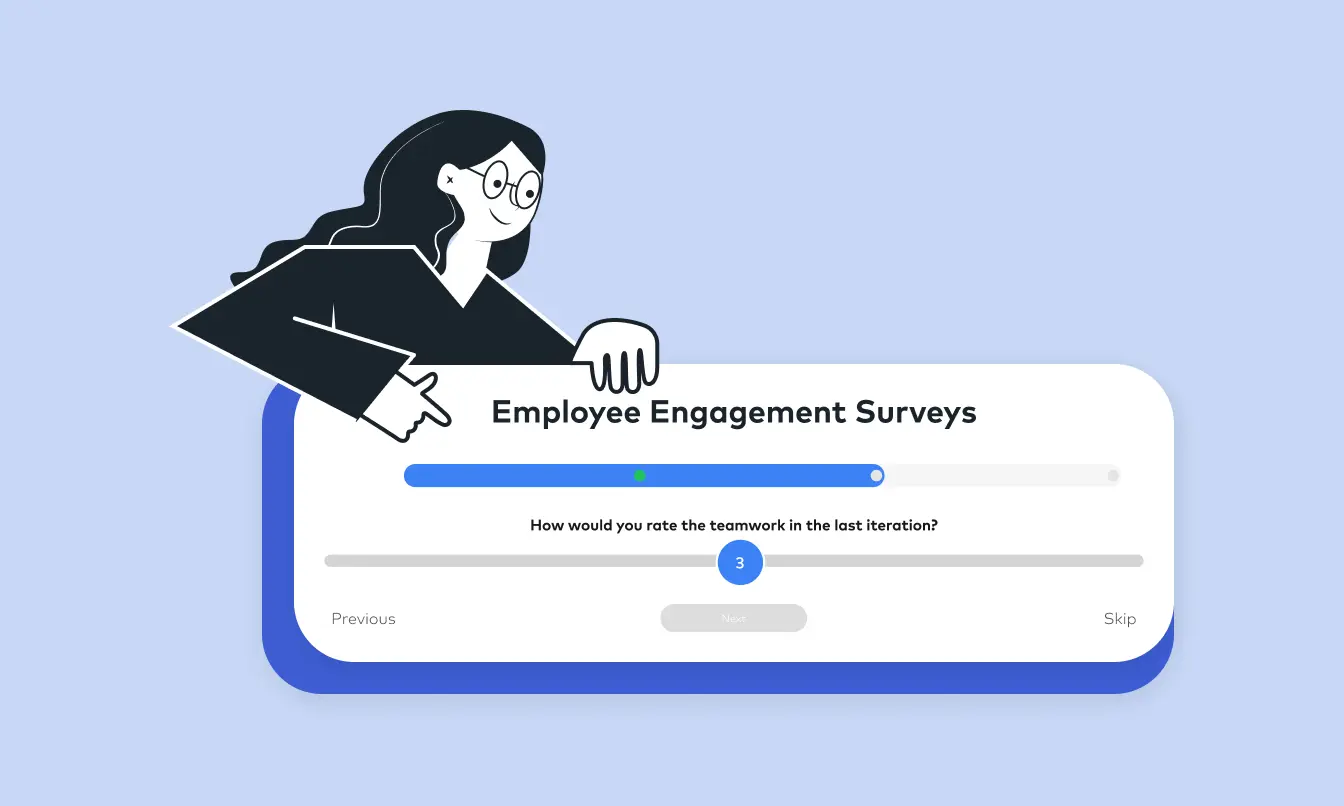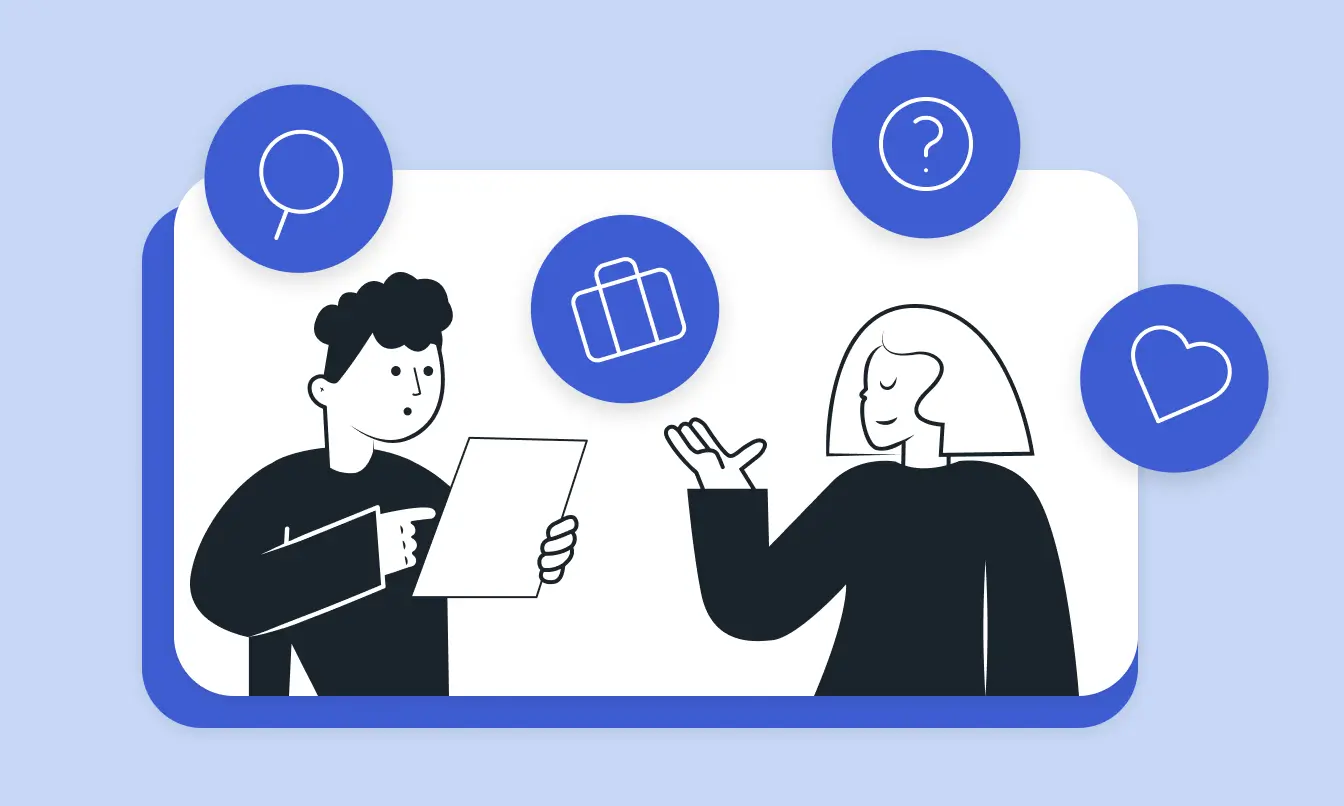
What Are The Alternatives To eNPS?


- 1- Employee Engagement Surveys
- 2- Pulse Surveys
- 3- 360 Degree Feedback
- 4- Stay Interviews
- 5- Focus Groups
- 6- Exit Interviews
- To Sum Up
The employee net promoter score (eNPS) is a widely used metric in business to measure employee satisfaction and loyalty. eNPS surveys are quantifiable, measuring how loyal and satisfied the employees of an organization are.
eNPS is a popular and handy tool in most organizations. We suggest you read “What is eNPS?” to better understand eNPS and its implementation for your company.
However, there are some alternative surveys in case a company can’t benefit enough from eNPS surveys; these alternatives also give valuable insights into a company’s trends, issues, management, etc.
It is also possible (even excellent) for an organization to use various surveys and eNPS to have a more thorough view of its status.
We will further explore 6 viable alternatives to eNPS to increase employee engagement and productivity. Bear with us to find out more about the best eNPS alternatives and their advantages and disadvantages.
Our Employee Survey Systems allow you to have specifically designed eNPS surveys to serve your company’s needs.
1- Employee Engagement Surveys

Employee engagement surveys are valuable for assessing and improving an organization's status, including employees’ devotion, motivation, and loyalty.
The questions of these surveys cover various aspects of the employee experience and work environment, such as satisfaction, communication, management, and professional growth opportunities.
As usual, there are some advantages and also drawbacks to this approach.
👍🏼The Advantages of Employee Engagement Surveys
Due to the thoroughness of this method, the results are comprehensive and helpful in several ways.
- These surveys estimate the overall status of an organization’s culture. By considering employees’ feelings and identifying a company’s growth capacity, they help organizations get valuable insight into their affairs.
- Organizations can apply these surveys for more information about their weak and strong areas. This way, they can develop faster and more efficiently.
- The sharing platform of these surveys creates a healthy and transparent work environment that engages employees.
👎🏼The Disadvantages of Employee Engagement Surveys
Even though the surveys are fulfilling and comprehensive, there are some drawbacks to keep in mind before conducting these surveys.
- The surveys are usually time-consuming and can’t be conducted frequently!
This factor may also affect the efficacy and reliability of the responses if employees get too exhausted to answer. - Some tampering is inevitable during these surveys. If employees don’t have a sense of job security, they will not bother with honesty.
Employee Engagement Surveys are essential for measuring a company’s overall status.
You can use our Employee Surveys services at agyleOS to conduct enhanced and unique surveys to improve employee-management communication.
2- Pulse Surveys

As the name suggests, Pulse surveys are a short and easy-to-apply assessment method, so an organization can send out these surveys often to track their trends.
Pulse surveys contain 3 to 10 close-ended or open-ended questions.
These surveys are applicable for quickly recognizing a company’s cultural state and evolving areas.
👍🏼The Advantages of Pulse Surveys
- Pulse surveys are not lengthy and tiresome, so an organization can send out more than one survey annually. This factor helps keep track of a company’s trends and patterns.
- Since the surveys are simple and brief, you can accept more rational and honest answers.
👎🏼The Disadvantages of Pulse Surveys
- Pulse surveys lack some thoroughness the other surveys provide.
- If the organization fails to act on the feedback from pulse surveys, employees will not bother answering the subsequent surveys.
Types of Pulse Surveys
As quickly applicable as pulse surveys are, they also provide an organization with several types to conduct in different circumstances.
Here are the two primary types that are used frequently:
1. Employee Pulse Survey
These surveys are short questionnaires to assess employee satisfaction, motivation, and loyalty.
Organizations must conduct employee pulse surveys regularly to evaluate the organization's overall status.
There are also three different types of Employee Pulse Surveys depending on when they are applied:
- Monthly Pulse Surveys, which contain 5-10 questions
- Quarterly Pulse Surveys, which have 10-20 questions
- Bi-annual/Annual Pulse Surveys, which include over 20 questions
Types of Questions In An Employee Pulse Survey
The questions differ depending on the pulse survey, such as a salary or management feedback survey.
For example, a typical monthly employee satisfaction survey should have 10-15 questions focusing on the employee experience:
- Add some close-ended questions like “How happy are you at work?”
- Add some rating questions: “On a scale of 0 to 10, how helpful is the manager when facing complex challenges?”
- Add a few open-ended questions about your status for thorough feedback: “What obstacles would cause you to leave our organization?”
2. Customer Pulse Survey
Customer pulse surveys help an organization comprehend the quality of its products/services.
The pulse surveys designed for customers must be short and understandable.
Companies can upgrade their reputation by leveraging the feedback and insights.
3- 360 Degree Feedback

360-degree feedback, also known as multi-rater or multi-source feedback, is a powerful measuring tool for organizations to assess the performance of individuals.
Despite the regular surveys that evaluate an employee’s work from a single point of view (usually by interviewing their supervisor), 360-degree feedback goes a long way to ask about an employee from themself, their co-workers, subordinates, peers, and other internal stakeholders.
720-degree feedback is when the method involves interviewing customers and other individuals outside work.
While 360-degree feedback is a robust tool, it also has limitations.
You should decide carefully if the advantages of this method outweigh the obstacles in your company’s situation.
👍🏼 The Advantages of 360-Degree Feedback
A well-structured 360-degree feedback survey can increase employee engagement, productivity, teamwork, etc. Moreover, there are also some unique advantages to this method:
- The holistic review that 360-degree feedback provides is rare in other surveys.
- This method advocates for both personal and organizational growth by identifying all the areas suited for improvement, points of weakness, and an overall performance rate.
👎🏼The disadvantages of 360-degree feedback
As with any method, 360-degree feedback also has some negative points. These consequences are especially significant if the review system is conducted poorly. The challenges below are essential to consider if you want to use a 360-degree review system:
- It takes a lot of time and resources. You’ll need more than four trained experts to rate an employee’s performance.
- This method is not a one-time survey and needs follow-ups. The first can only cause miracles if the leaders also do the following 360-degree reviews.
- If the raters aren’t trained well, conflicts might be caused during the interviews.
- Even though 360-degree feedback is a powerful tool, it is not handy for small companies with fewer resources.
By leveraging the insights from 360-degree feedback surveys, an organization can identify its best employees, create more development opportunities, build better communication, and improve its work environment.
If you need help with proper 360-degree feedback, we recommend using our Employee Performance Review Software at agyleOS.
With our up-to-date skill matrix, you can build your unique skill database while encouraging employee engagement and simplifying a dynamic management approach.
4- Stay Interviews

Stay interviews are one-on-one conversations with employees to increase retention rates.
Unlike exit interviews, which are helpful when employees leave their company, stay interviews are held with current employees to identify top performers and address their needs and potential issues.
In other words, stay interviews are a way to prevent exit interviews from happening.
The primary goal of stay interviews is to prevent employees from turning to rival companies.
If stay interviews are conducted regularly, organizations will have a deeper understanding of their employees’ status and live up to their expectations.
👍🏼 The advantages of stay interviews
Stay interviews are a great way to look into your employees’ minds. They offer various benefits, of which we have named a few below:
- Besides increasing retention rates, stay interviews demonstrate the patterns and trends in the organization.
- Stay interviews also create a safe, sharing platform that strengthens the employee-manager relationship.
👎🏼 The disadvantages of stay interviews
No method comes challenge-free. There are some difficulties with stay interviews as well:
- The interviews might get unpleasant if the employee reveals all their sentiments, especially if they have issues with management.
- An organization must act on the results of interviews to ensure employees have trust.
- Employees would only be sincere if they had a sense of job security.
- The interviews are usually time-consuming, especially if you plan to have them regularly.
What Questions And Tips To Use In a Stay Interview
The questions in a stay interview are usually open-ended and heart-to-heart.
You should show your employee that you value them and their work.
You can ask questions like: “How do you feel about working in our organization?” or “How good is your relationship with your manager?”
You must keep the interview atmosphere respectful and welcoming.
Employees will only give you genuine feedback if they feel their position is protected.
5- Focus Groups

Focus groups involve gathering a group of employees to discuss work-related topics or issues in a safe space.
This method increases the communication level and identifies areas for improvement.
A well-structured and standard focus group allows employees to express their sentiments toward their workplace and expose any underlying problem.
If the provided space is safe and supportive, the discussions in the focus groups will empower management and HR departments to take proactive steps toward enhancing the employee experience.
Tips For Conducting A Successful Focus Group
Although focus groups seem straightforward, they can create more damage than good if conducted improperly. You must know everything about the method at hand.
-
Choosing participants
A focus group represents your company. However, it should contain at most 12 employees.
A few participants ensure everyone gets to share and discuss their issues and needs.
The chosen employees for the focus group must be from different departments, and the selection shouldn’t be under any personal discrimination.
-
Putting a suitable facilitator and coordinator in charge
Facilitators control the sessions' flow and ensure everyone contributes to the discussions.
They play a significant role in how employees respond to questions.
Facilitators should have a few characteristics: objectivity, friendliness, responsibility, and attentiveness.
Coordinators, however, plan the sessions according to everyone's schedule to avoid any interference.
Selecting an organized and responsible coordinator for a focus group matters since they will be in control of the whereabouts of the meetings.
-
Developing the proper questionnaire
To achieve worthwhile results from a focus group, you must ask relevant, specifically crafted questions.
The questions in a focus group are primarily open-ended; however, it’s best to limit their number to keep employees out of boredom.
Types of Questions In A Focus Group Meeting:
Introductory questions: The facilitator can start the session by asking, “How do you describe your work to your family and friends?” or other general questions.
Significant questions: There are some must-have questions to include in the session: “What are the obstacles to your professional growth in your organization?” or “What are the reasons for you to consider working for another organization?”
Final questions: the facilitator finishes the session by simply asking if the employees want to share anything they haven’t covered in the meeting.
Organizations need to know how to conduct a well-structured focus group.
Having a regular and guided agenda for the focus group meetings and analyzing the given data gives you insights into your company’s issues and trends.
Focus groups are an excellent method to take proactive steps for your organization’s status.
One of the ideal approaches to identifying and handling a focus group is having Interactive Org Charts in addition to Skill Matrix Software.
At agyleOS, we provide these services that allow you to monitor and optimize your team’s performance.
6- Exit Interviews

Exit interviews are conducted when an employee wants to leave the organization. Exit interviews usually occur after employees submit their resignation letters and before their last day.
These interviews intend to identify their reasons for departure.
Since the employees are leaving the organization, exit interviews provide one last chance for them to express their sentiments and feedback candidly.
An exit interview usually takes place with an HR professional asking questions.
You can also send out the questionnaire for the employee to answer on their own.
Types of Questions In An Exit Interview
Following an agenda and developing a suitable questionnaire for an exit interview allows you to get insights into your employee’s resignation.
There are four typical categories of questions in an exit interview:
- Reasons for departure
- Employee experience
- Work culture and work environment
- Resources
The questionnaire must cover all the basics wholly and briefly so that an organization would have applicable data on why their employees would leave their company.
Question Template For An Exit Interview
It is evident that each organization should craft a questionnaire to match their company’s status and needs.
But here are some examples to put in your exit interview:
- Questions about their reasons for departure: “Why do you want to cease working with our organization?” or “Was there anything we could do to keep you on our team?”
- Questions about their employee experience in your organization: “Did the job live up to your expectations? If not, why?” or “Do you think your position could have had more growth opportunities? If yes, how?”
- Questions about work culture and environment: “How would you describe your workplace?” or “Did you have any problems with our company culture? If so, What are they?”
- Questions about Resources: “Were you provided with enough resources and tools to do your job properly? If not, what did we miss?” or “How equipped do you think our organization is to handle challenges and difficulties?”
Tips To Conduct Effective Exit Interviews
Even though your employee is leaving your organization, having a proper exit interview gives you helpful insights into your company’s trends and issues.
Here are some tips on benefitting from an exit interview:
- Ensure every leaving employee gets an exit interview. According to Harvard Business Review, 25 percent of businesses don’t conduct an exit interview. Most of the remaining 75 percent don’t track or analyze the data correctly.
- Have a relevant and uniquely designed questionnaire compatible with your company, each employee, and each department.
- Interpret the data from the exit interviews to gain insight into your shortcomings and potential threats.
- Most importantly, take action to increase retention rates and employee engagement.
The primary advantage of exit interviews is that an organization can receive honest reviews.
These interviews may be unpleasant or harsh, but they play an essential role in identifying the factors affecting employee retention.
Also, you can protect your company’s name and reputation by conducting respectful and comfortable exit interviews so that even your soon-to-be former employee knows they are a valuable asset.
To Sum Up
Even though eNPS is now a trending measuring tool for employee satisfaction assessment, it might be shy of a few features, including full transparency, covering all the aspects of the job, having multiple points of view, etc.
Each employee review that we discussed has some unique features and drawbacks.
If an eNPS survey fails to serve your company solely, we recommend you use a combination of surveys to assess the overall health of your organization.
If you have doubts about what survey is compatible with your company, we are here at agyleOS to help you analyze your needs.
By submitting this form, I confirm that I have read the privacy policy and that I consent to the processing of my personal data by agyleOS for the purposes stated. In the event of consent, I can revoke my consent at any time. Furthermore, by submitting the form, I agree to the general terms and conditions.


- Product
- Resources
- Compare
- Company
